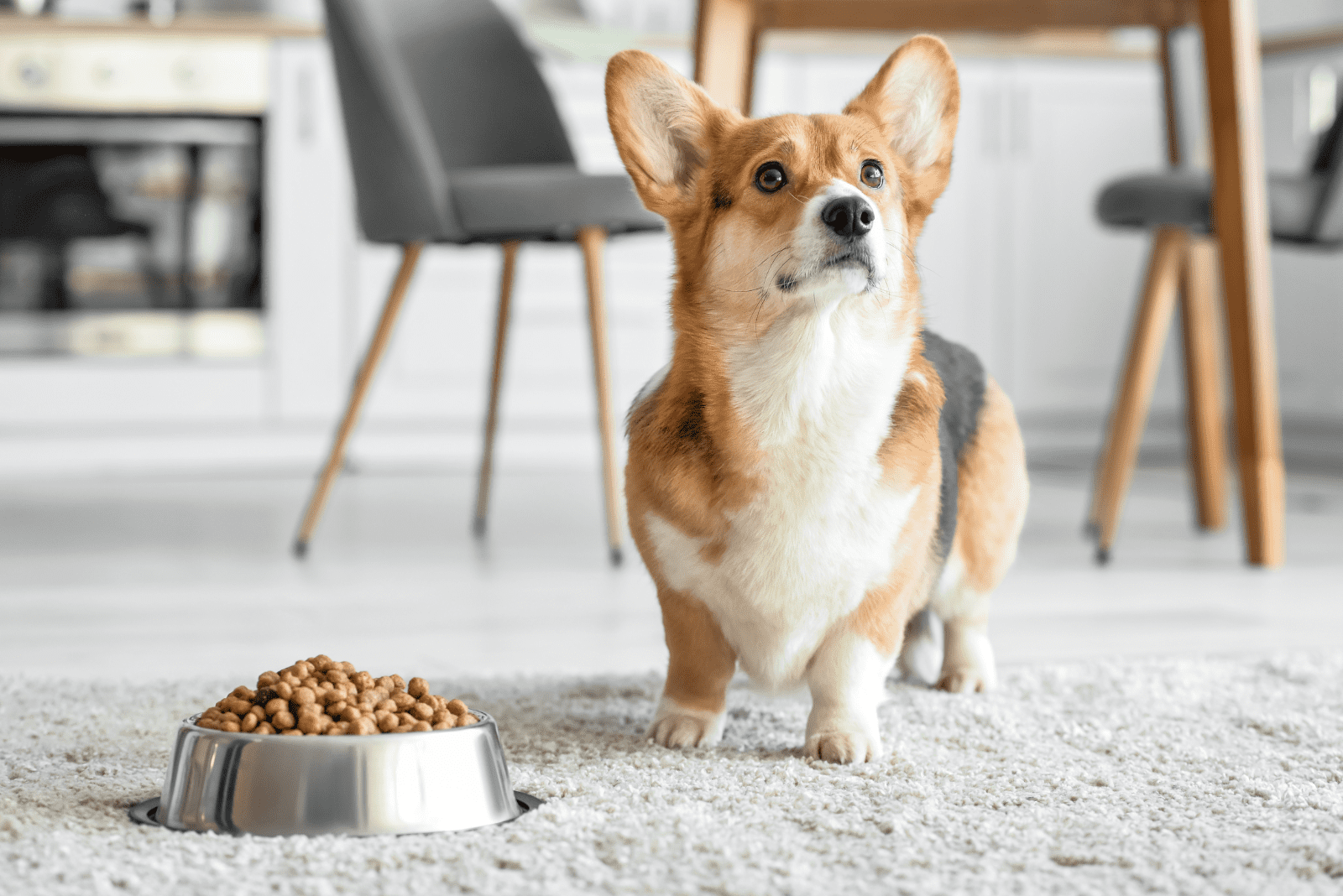Someone has got a new Corgi puppy! Yeah, you!
I bet you’re thrilled to become the owner of such a wonderful dog breed!
Besides the usual troubles that all fresh dog owners have, like picking the right name, another problem occurs: How to feed my Corgi puppy.
Here’s where PupVine’s Corgi feeding chart comes to help.
Today, in this useful feeding guide, you’ll learn everything you need to know about proper feeding schedules, picking the right dog food, and solving problems with your pup’s nutrition.
Trust me… feeding a dog isn’t just throwing some kibble in a bowl – there’s a whole science behind it. Your dog’s nutritional needs are more demanding than you think.
There’s a good reason why your dog’s diet must be packed with more high-quality proteins, vitamin A, and minerals like phosphorus, calcium, and fiber instead of empty carbohydrates.
What else should be contained in that delicious bowl of dog food? You’re about to find out!
Corgi Feeding Chart By Age
From the beginning of their life up to the age of six weeks, puppies are kept with their mother. They rely on their mommy’s milk for food, comfort, and love. It’s the crucial time to build up the pup’s immune system so he grows up strong.
But still, the time to wean them will come soon.
Slowly, but steadily, you or the breeder should introduce puppy food. It’s a matter of small amounts of kibble that should satisfy your puppy throughout the day. The amount will increase, so your Corgi puppy grows according to the recommended Corgi growth chart.
Down below, you have a useful Corgi feeding chart that is appropriate to different weeks and months of puppyhood.
[table id=533 /]
This is a general idea of how much to feed your Corgi puppy. However, I don’t see many dog owners using it because it’s rather difficult to calculate how much 0.15 cup is exactly. Instead, dog owners stick to the Corgi feeding chart down below. Let’s keep this one for professional use only.
Puppy Feeding: How Much Should A Corgi Puppy Eat?
[table id=534 /]
How Much Should An Adult Corgi Eat?
In other words, how many calories should you allow your Corgi to eat on a daily basis?
Calories aren’t necessarily bad, especially when you’re a dog like a Corgi, with high energy requirements. They help us push forward and gather strength for strenuous exercises.
Usually, all dog food brands have the recommended calorie intake on the back of the bag, but I always recommend you have an individual approach with your dog. Dogs normally don’t fit into patterns. What works out for one Fido might not work for yours.
I remember picking up a dog food bag one time and it had completely wrong information on the back. The recommended calorie intake was too low for my dog. So, I did what I had to do… math.
With a simple calculation, I was able to figure out my dog’s RER (or Resting Energy Requirement).
How is this done?
Quite simple…
Measure your dog’s weight in kilograms, and multiply it by three-fourths power by 70. The end result is your dog’s RER, or the number of calories your Corgi buddy should take.
Should Corgis Have A Feeding Schedule?
[table id=535 /]
As you can see from the Corgi feeding chart above, you can establish a feeding schedule according to the pup’s age. Of course, Corgi puppies won’t have the same schedule as adult dogs. Their digestive system is still developing, and they can’t take the same amount of food.
The same goes for teacup Corgis. Even though they’re technically adults, they’re still one of the teacup dogs. It’s a general rule of thumb that all puppies, no matter if they’re big- or small-breed dogs, need more meals throughout the day. They’re growing and developing, and they need good fuel to keep them moving.
Puppies also have a high activity level, meaning they need a boost to help them play all day long.
For most of their childhood, Corgi puppies will have around four meals a day. The recommended calorie intake shouldn’t go overboard. Make sure you divide those calories into the recommended number of meals, so your Corgi puppy grows up nice and healthy.
Once a Corgi puppy turns an adult, the number of meals should significantly decrease. But, the importance of regular meals and proper calorie intake does not decrease. You should still monitor your dog’s food intake to prevent him from becoming a chubby Corgi.
I do want to point out that these general rules apply only to healthy dogs. It’s only natural to say that dogs with bloat or other conditions should not stick to one or two meals a day. They should have the same feeding schedule as puppies.
How To Switch From Puppy Food To Adult Food
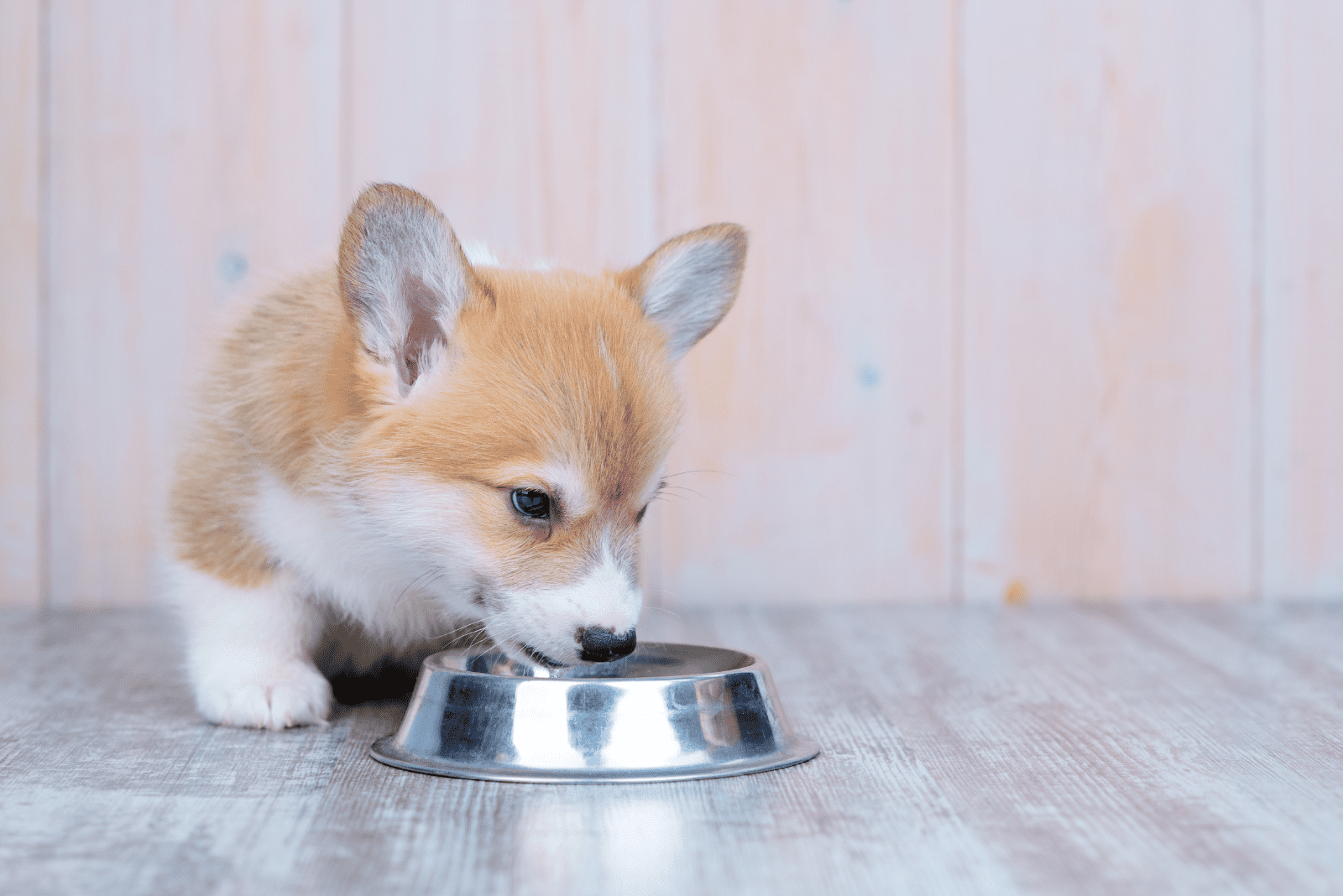
Every change in your dog’s diet should happen gradually. Rarely does any dog accept sudden changes very well. Nothing should be done abruptly and without consulting your vet.
If it’s time to switch from puppy food to adult food, then you need a little help from a professional so you can avoid stomach problems, vomiting, rejecting the food, etc.
If a dog doesn’t like its chosen food, chances are he will respond with some of the symptoms mentioned above. Usually, dogs just refuse to eat until you bring them a whole new kibble recipe. That’s one of the biggest reasons why a dog will eat treats, but won’t eat his food.
Most dogs become adults at the age of 12 months. Well, in the Corgi’s case, that’s the age they should stop being puppies and start acting like big doggos. You can either do the switch prior to their birthday, or sometime after.
As I mentioned, the switch should happen gradually. Replace a bit of your puppy’s food with the new food, and increase the amount until it’s all switched… of course, if the new food suits your Corgi puppy.
Usually, dog owners pick the same brand of kibble they used for their puppies because the recipes are similar. There’s more of a chance that your Corgi will accept it.
During the switch, watch for any reaction coming from your dog.
What Do Corgis Need To Eat?
Food.
Just kidding, of course, I’ll point out exactly what Corgis are supposed to eat.
Not every dog breed needs the same nutrients or should consume the same ingredients. If you have any knowledge of feeding dogs, then you’ll know that Dalmatians must avoid purine-based food in order to prevent bladder stones.
But, do Corgis need to be on a special regime?
Not exactly, but you do have to watch their daily calorie intake.
Like all dogs, Corgis need protein-rich food. The most common choice is chicken kibble, but I like to recommend fish-based ones, too. Salmon and white fish are a terrific choice, followed by turkey, lamb, beef, and venison.
These are the most popular protein sources on the market. I’d suggest you pick light proteins first since Corgis should have a low-calorie diet that’s also low in fats.
Fillers and artificial flavors should be avoided. Instead, use recipes that feature fruits and veggies. They’re an excellent source of minerals, fibers, and vitamins. A lot of them, i.e., blueberries, contain antioxidants. I’d always pick a formula featuring turkey, blueberries, kale, and sweet potatoes more than anything else.
Luckily, dog food brands have recognized the importance of superfoods. They tend to use a lot of them, such as chia seeds, to enhance their recipes.
All of these goodies are essential to every Corgi feeding chart. If you add omega fatty acids, l carnitine, and glucosamine, you get the pawfect formula fit for your Corgi!
Should Corgis Eat Wet Food Or Dry Food?
Picking the right food is the toughest task for any dog owner. Choosing the brand isn’t the only problem: it’s choosing the texture, too!
Dogs don’t have a huge choice. It’s either kibble or wet food. But, which benefits does each option carry? Should Corgis prefer one food type over the other?
The truth is, kibble is better for your dog for several reasons. Sure, wet food is fine, but this shouldn’t be the preferred option, especially not for a Corgi puppy.
Dogs need to exercise their jaws, and this is where kibble comes to help. Wet food should only be served occasionally, or as a treat.
The reason why a lot of dog owners pick wet food over kibble is the fact that it’s definitely tastier for your dog. I mean, I haven’t tried it, but chunks of meat in some sort of a sauce are always better than rock-hard pebbles.
Wet food consists of a lot of fats, and that’s nothing to be played with. Fats are okay, but in a moderate amount.
The biggest downside of wet dog food is definitely the price. Food cans are pricier than a bag of kibble. You can also find dog kibble at an affordable price if you buy big bags. Trust me – your dog will eat all of it.
Dry dog food is more beneficial for the dog’s dental health. Chewing on kibble will ensure that your dog has cleaner teeth and a strong jaw. Wet food can damage your pup’s teeth if he eats it too often.
If you want to put your Corgi on a special, low-calorie diet, then dry dog food is the way to go.
As far as the Corgi dog breed is concerned, PupVine has done thorough research on which Corgi dog food is the best one.
Should Corgis Eat Raw Food?
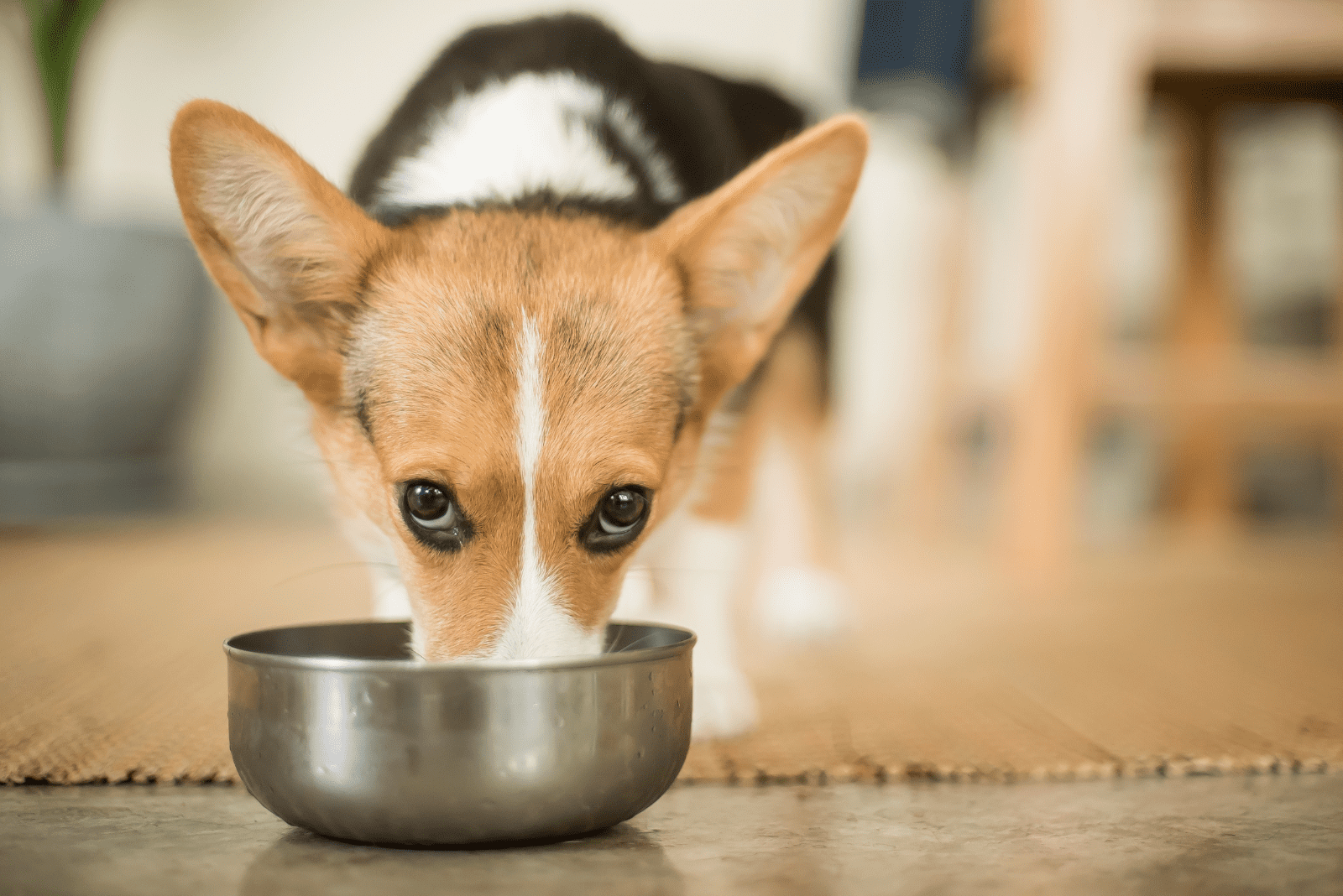
I see no reason why Corgis shouldn’t eat raw. Raw dog food is highly beneficial for a growing puppy, as well as for adult doggos.
You have perfect insight into what you’re feeding your dog. You can throw in the best ingredients you can find, especially if your dog has some sort of food allergy.
But, you can also pay a pretty high bill for this kind of diet.
Raw dog food, despite its many benefits, has lots of flaws.
The biggest one is definitely the cost. Corgis aren’t that pricey, but raising them can be.
It’s always pricier to buy fresh ingredients and prepare batches of food rather than buying from someone that produces these meals in bulk. However, the price does not guarantee longevity.
Raw dog food can go bad pretty fast. You can store it in the fridge, but it still won’t last long. That’s why people who prepare raw dog food make big batches and freeze them to use whenever needed.
Raw dog meals are also time-consuming. You will need to spend lots of time preparing them. If you do have free time on your hands, then I’d recommend you go on this raw adventure. But, if you don’t, pick another way of feeding your dog.
Should You Free-Feed Corgis?
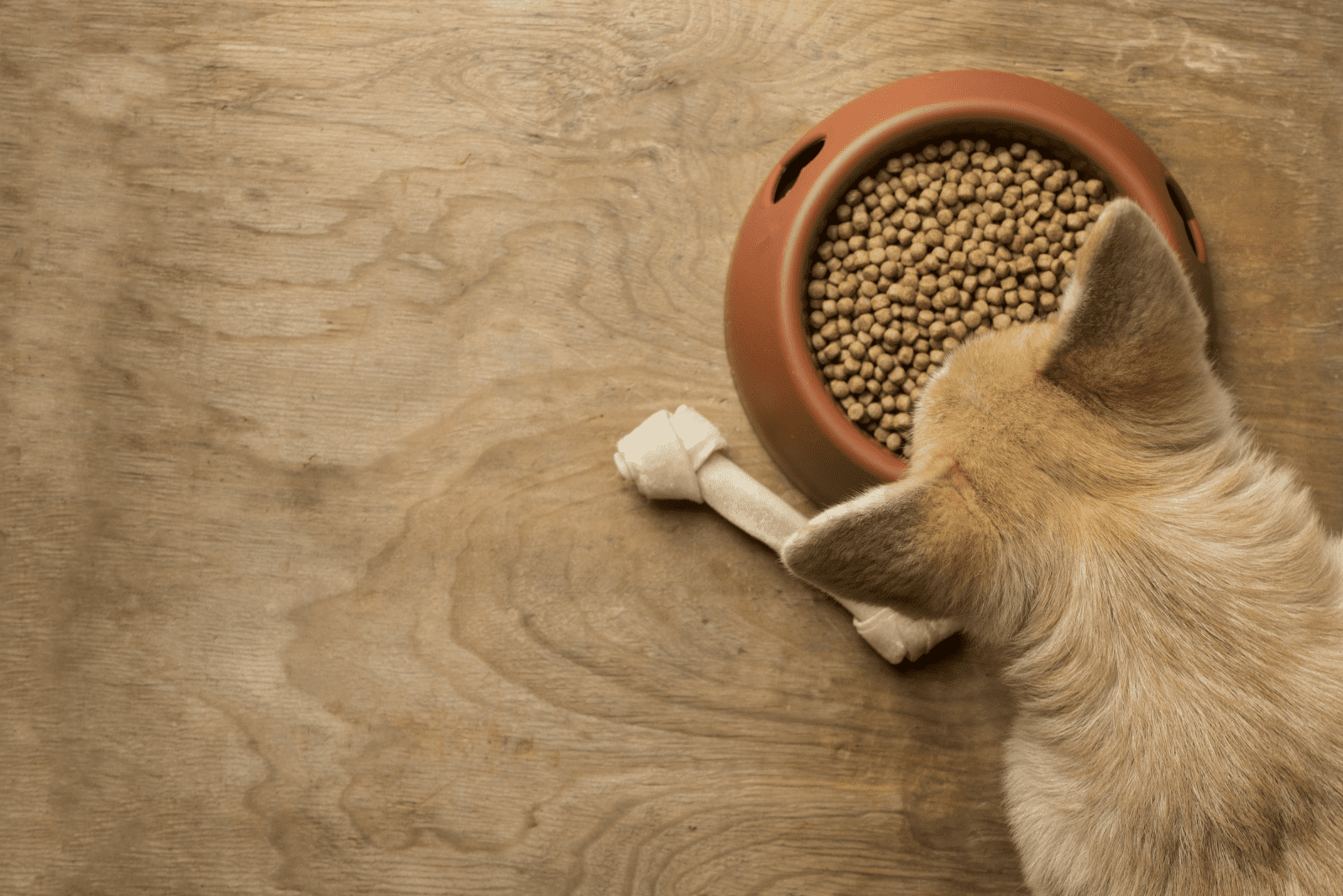
It’s never a good idea to free-feed your Corgi.
In fact, it’s never a good idea to free-feed any dog breed. All dogs love to eat, and they really can’t control themselves when yummy food is served. If you leave the food out for too long, chances are your dog will eventually become obese.
Obesity with Corgis is a common problem that you must prevent. When you compare male with female Corgis, females are less likely to become obese, but still…
Their body can’t take excessive weight that doesn’t match their weight chart. When you free-feed a dog, you have no idea how much food he has. It could be two days worth in one sitting.
That’s only the first reason why we should avoid free-feeding.
Also, if you let your dog eat as much as he can anytime he can, you won’t be able to see if he has some issues with eating. Dogs usually stop eating or eat only a bit if they’re experiencing some health problems.
Lastly, I want to point out something that most of us don’t really think about. It’s leaving out food for too long. This only applies to wet food because dry dog food or kibble has a different texture and a longer expiration date.
When you leave wet food out for too long, you risk food poisoning because of all the bacteria. Within two hours, room temperature will affect your dog’s meal, and it will become fertile ground for bacteria development.
Neither we nor our canine friends should eat wet food that has been set out for too long.
Are Supplements Good For Your Corgi?
Supplements and homemade meals go hand-in-hand.
Already-prepared dog kibble or wet food contains these supplements, and you don’t have to worry about adding them.
However, if you prepare meals at home, you should consult your DMV about which supplements to use. It’s not something you can decide on your own.
Some dogs may need supplements for stronger bones and joints while others might need them for healthier skin, etc.
The important thing is not to overuse them – dose them exactly the way your vet prescribed you.
If your dog eats fine, has no health issues, and behaves the way he should, then there’s no reason why he should be on some sort of supplement. A balanced diet packed with real animal proteins, fruits, vegetables, and a bit of grain (if not allergic) is everything your healthy Corgi needs.
Health Conditions Related To Food Intake
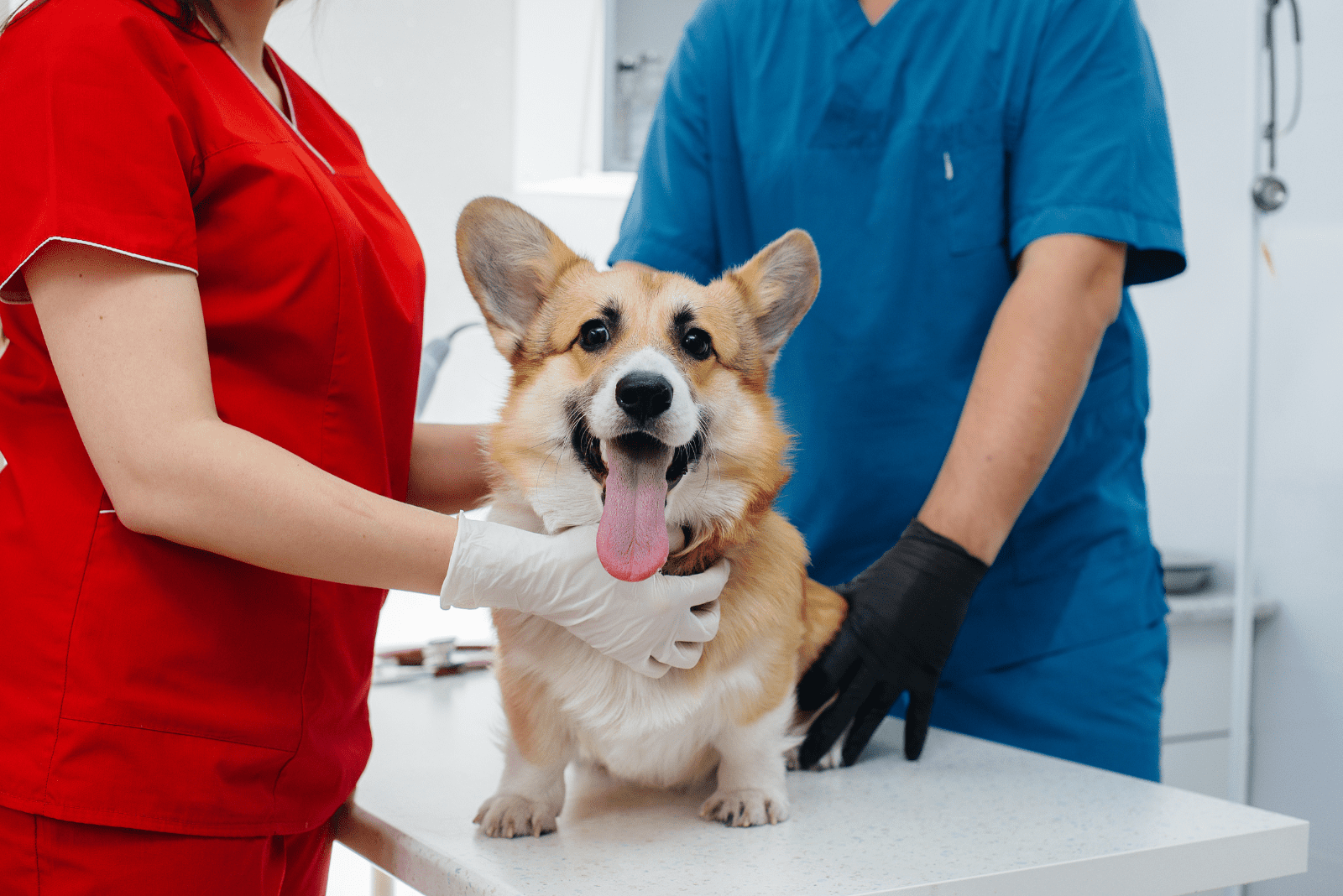
Food intake can be linked to different health problems, and those problems can be quite difficult to handle.
A lot of dogs these days are prone to developing some sort of food-borne allergies. Even though people think it’s always the grains’ fault, the biggest allergy trigger is actually chicken! It definitely has a lot to do with many antibiotics that mass producers use to feed their chicks.
Food allergies can be detected easily with several tests run by your vet. Also, you can suspect them if your dog’s poop is different than usual, or if he develops rashes, vomits frequently, seems to be too flatulent, etc.
Bloat is definitely the most common health concern regarding food intake. I can’t stress enough how important it is to slow-feed your Corgi, and feed only the right amount of food.
Dogs like Corgis that are prone to bloat shouldn’t exercise heavily prior to a meal, and they shouldn’t eat too fast. Down below, you’ll find some helpful tips on slow-feeding your Corgi buddy.
Besides bloat, Corgis can become obese, which then leads to other conditions such as hip dysplasia, elbow dysplasia, intervertebral disc disease, etc.
What To Do If Your Corgi Refuses To Eat
It is hard to believe it, but Corgis can also refuse to eat. It’s not because they don’t want a meal. It’s because they’re experiencing some sort of health issue or discomfort.
The least serious problem with refusing food is issues with the chosen dog food brand. You’ll recognize this immediately if your dog eats treats, but won’t eat his food.
What you can do is change the dog food brand you trust. Pick another kibble brand based on your dog’s preferences. I recommend you go with a similar ingredients’ list, but make sure you contact your vet first and ask for his approval.
When my dogs used to refuse their meals sometimes, I always tried mixing their food with the wet dog food I used for their treats. They loved it! If your Corgi seems to be picky, maybe sneak in a few snacks from this list of the best Corgi snacks on the market.
However, one foster dog that spent his last year with me and my buddies ended up having a change of heart overnight and stopped liking our chosen dog food brand. I tried everything, and I eventually had to pick a separate kibble just for him.
If mixing kibble and offering other brands doesn’t work, it’s time to consult your DMV.
What To Do If Your Corgi Is Always Hungry
It’s not uncommon for Corgi puppies to show hunger all the time. These doggos love to eat! However, constant hunger and frequent feeding aren’t the happiest solutions for Corgi dogs.
If you want the best for your dog, you won’t allow him food all the time. Let’s look at the bigger picture. Corgis are rather small dogs. They have a long body and short legs. If you feed them too much and too often, they will pack on additional weight.
Imagine carrying too much body weight on those stubby legs. It’s not easy. Why would you allow such a thing to happen to your dog? Overeating leads to other health problems; not only obesity. For example, bad feeding habits may lead to hormonal disturbance and/or thyroid problems.
Corgis aren’t usually picky eaters like Poodles, for example. They will eat pretty much anything you serve them.
However, this doesn’t mean you should let your dog have a bite of your sandwich. Also, your pooch shouldn’t have human food like Doritos or chocolate.
No matter how much your Corgi begs you for a bite, stick with your feeding schedule and don’t lean to overfeeding… ever.
How To Slow-Feed Your Corgi
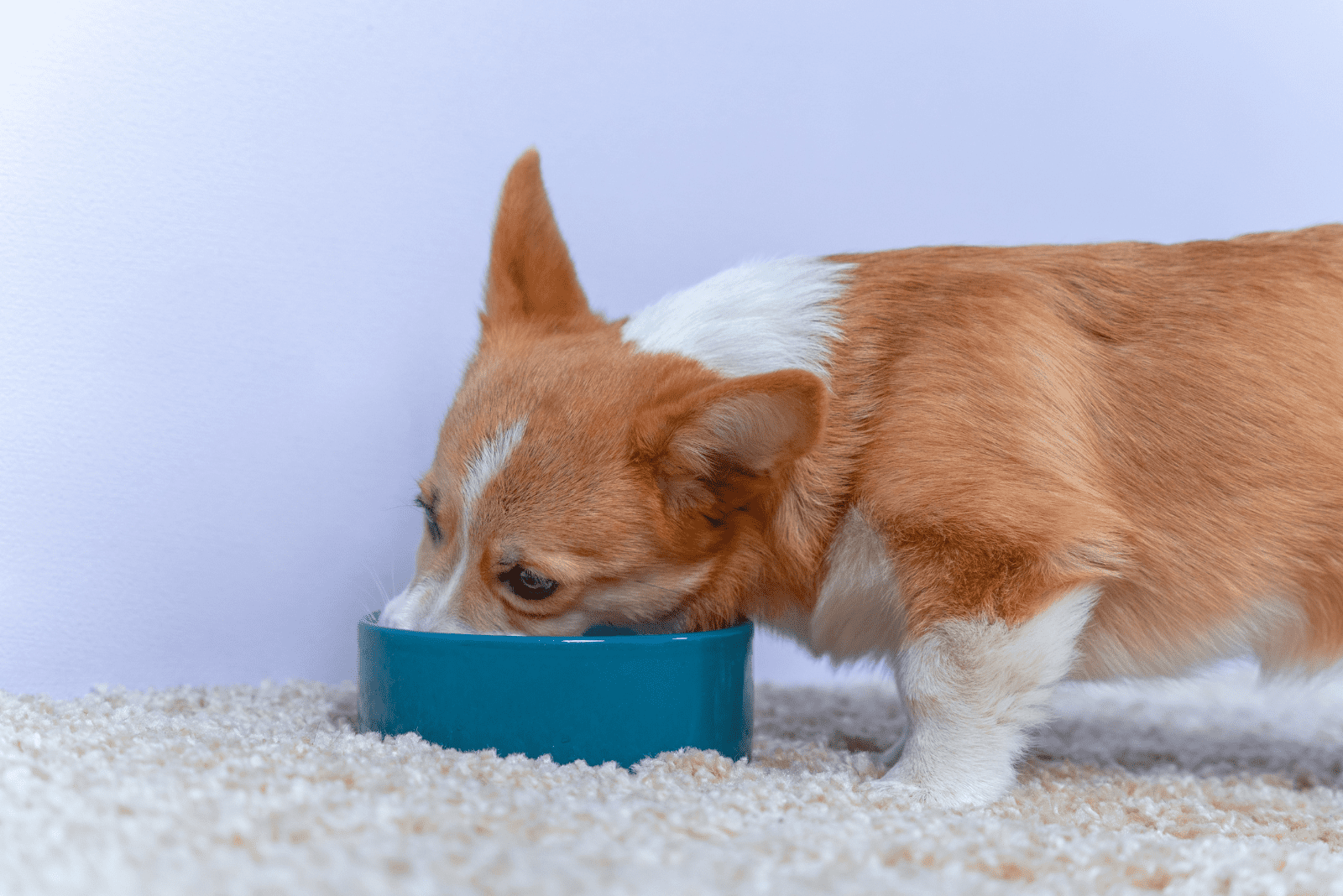
Of all the health conditions that strike Corgis, bloat is the one that bothers me the most. Simply put – fast eating and a small body frame don’t go well together. Corgis are notorious for being greedy when it comes to food. They never get enough of it, so naturally, bloat could strike anytime.
But, bloat is preventable, and one of the best prevention methods is slow-feeding your Corgi.
I know what you’re thinking because I was the same. Slow and Corgis don’t go hand-in-hand. But, there are ways in which you can train your Corgi pooch to eat slowly (or normally) in order to prevent stomach upsets, bloat, and even obesity!
We’re about to learn a thing or two about those ways. I’m pawsitive you’ll find this helpful if you’re a fresh Corgi owner.
More Meals Throughout The Day
Frequent meals are always a safe card to play, no matter if you have a Corgi or any other dog breed that is susceptible to developing similar conditions.
What you can do is serve more meals throughout the day, but keep the same amount of food on a daily basis. This means smaller meals and less of a chance for your dog to eat like crazy and get stuffed with too much air.
Don’t go over your pup’s daily calorie intake.
Creating A Feeding Schedule
Always stick to your feeding schedule.
Humans like to snack all the time, whether it’s just some fruits, party mixes, or sweets with coffee. Dogs don’t need the same regime… neither do we, but that’s a whole other problem.
Your Corgi needs a feeding schedule that should consist of two or more meals throughout the day. That’s it. No snacking, no free-feeding at all!
Sure, you can reward your pup during training lessons, but only if he likes a treat-based reward system. Ear scratches and tummy rubs work, too, in case you’ve forgotten about them.
Slow Feeder
Lately, I’ve seen a lot of slow feeders or puzzle feeders on the market. The industry has gone in that direction, and I can’t say I’m not excited about these nifty gadgets.
Slow feeders help a lot with dogs that eat fast.
These innovative food bowls usually have some mazes, swirls, and other shapes inside the area where the food goes, so your dog has to work really hard to get all the kibble.
Extra points go for slow feeders with a really twisted design!
I’d like to recommend puzzle feeders, too, because they make your dog think hard about how to get that yummy-smelling treat, and where it is hiding.
Final Words
Now that you have basic knowledge of the right Corgi feeding chart, you’ll be able to guide your dog through all the stages of his life: from puppyhood to an adult dog, and senior years.
PupVine’s feeding guides for Corgis will provide you with the most useful information about what’s wrong and what’s right, which food to pick, and what to look for in a bag of dry kibble or in a can of wet food.
All Corgi owners should want only high-quality ingredients for their pooches. A Corgi puppy needs lots of care in order to grow into a healthy adult doggo.
As you can see, I didn’t talk about which brands to choose, like Purina or TOTW. That’s completely up to you. But, I hope I gave you a good idea about what to include in your dog’s diet and what to skip.
The best dog food for your Fido isn’t the one that is rated well on Amazon or Chewy. It’s the food with good ingredients that keeps your dog full and healthy, and helps follow the proper Corgi feeding chart.
